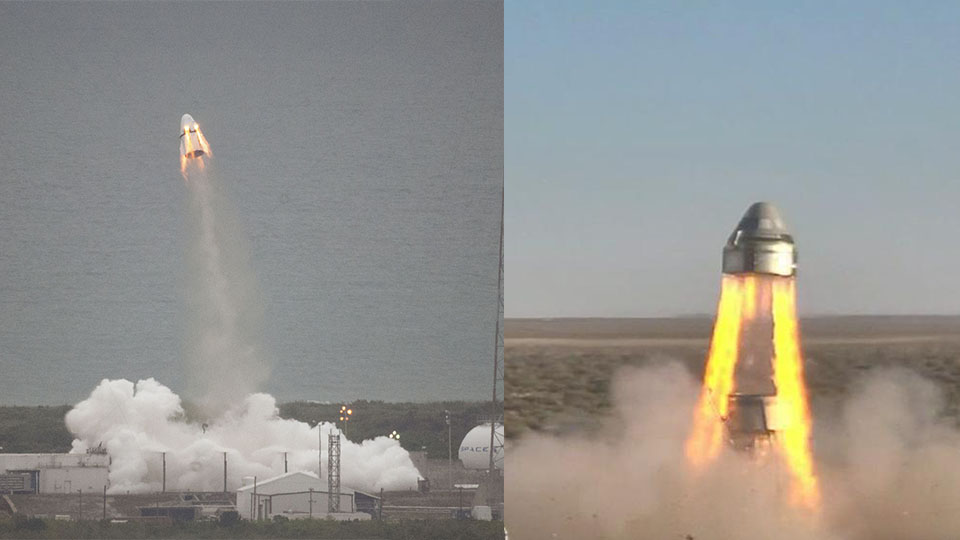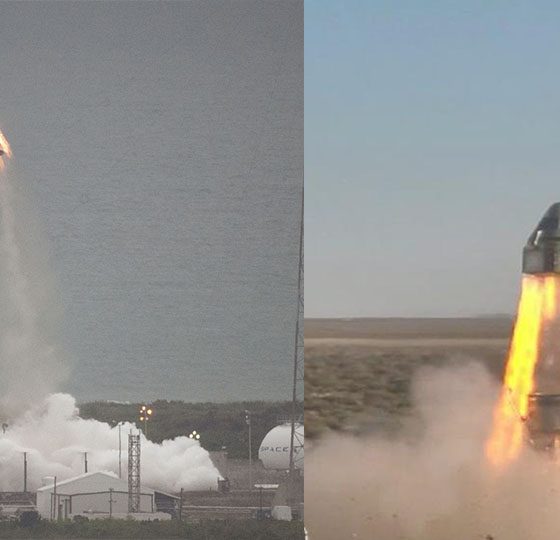

News
Boeing Starliner abort test (mostly) a success as SpaceX nears Crew Dragon static fire
On November 4th, Boeing completed a crucial pad abort test of its reusable Starliner spacecraft, successful in spite of an unintentional partial failure of its parachute recovery system. Three days later, Boeing revealed what it believed to be the cause of that anomaly in a November 7th press conference.
Meanwhile, SpaceX – having completed Crew Dragon’s pad abort test in 2015 – is preparing for an equally important In-Flight Abort (IFA) test and is perhaps just a day or two away from static firing the Crew Dragon capsule assigned to the test flight.
According to a NASA press release after the test, it “was designed to verify [that] each of Starliner’s systems will function not only separately, but in concert, to protect astronauts by carrying them safely away from the launch pad in the unlikely event of an emergency prior to liftoff.” Although the test wasn’t without flaws, the pad abort test successfully demonstrated the ability of the four launch abort engines and control thrusters to safely extricate astronauts from a failing rocket.
Those theoretical astronauts would have almost certainly survived the ordeal unharmed despite the failed deployment of one of Starliner’s three main parachutes, testing the spacecraft’s abort capabilities and redundancy quite a bit more thoroughly than Boeing intended. To put it bluntly, Boeing’s above tweet and PR claim that the failed deployment of 1/3 parachutes is “acceptable for the test parameters and crew safety” is an aggressive spin on a partial failure that NASA undoubtedly did not sign off on.
Boeing and SpaceX have both suffered failures while testing parachutes, leading NASA to require significantly more testing. However, in a November 7th press conference, Boeing revealed that Starliner’s parachute anomaly wasn’t the result of hardware failing unexpectedly under planned circumstances, but rather a consequence of a lack of quality assurance that failed to catch a major human error. Boeing says that a critical mechanical linkage (a pin) was improperly installed by a technician and then not verified prior to launch, causing one of Starliner’s three drogue chutes to simply detach from the spacecraft instead of deploying its respective main parachute.
Space is Parachutes are hard
Parachutes have been a major area of concern for the Commercial Crew Program. Both SpaceX and Boeing have now suffered failures during testing and have since been required to perform a range of additional tests to verify that upgraded and improved parachutes are ready to reliably return NASA astronauts to Earth. Although the Starliner pad abort test did indeed demonstrate the ability to land the capsule safely under two main chutes, an inadvertent test of redundancy, the series of Boeing actions that lead to the failure will almost certainly be scrutinized by NASA to avoid reoccurrences.
Boeing believes that the parachute failure won’t delay the launch of Starliner’s Orbital Flight Test (OFT), currently targeting a launch no earlier than (NET) December 17th. However, it can be said with some certainty that it will delay Starliner’s crewed launch debut (CFT), at least until Boeing can prove to NASA that it has corrected the fault(s) that allowed it to happen. SpaceX is similarly working to qualify upgraded Crew Dragon parachutes for astronaut launches, although the company has thus far only suffered anomalies related to the structural failure of parachute rigging/seams/fabric.
Abort tests galore
Boeing’s Starliner pad abort test occurred just days prior to a different major abort test milestone – this time for SpaceX. SpaceX Crew Dragon capsule C205 will perform a static fire test of its upgraded SuperDraco abort system, as well as its Draco maneuvering thrusters.
SpaceX has made alterations to the SuperDraco engines to prevent a failure mode that abruptly reared its head in April 2019, when a leaky valve and faulty design resulted in a catastrophic explosion milliseconds before a SuperDraco static fire test. Prior to its near-total destruction, Crew Dragon capsule C201 was assigned to SpaceX’s In-Flight Abort test, and its loss (and the subsequent failure investigation) delayed the test’s launch by at least six months. Crew Dragon’s design has since been fixed by replacing reusable check valves with single-use burst discs, nominally preventing propellant or oxidizer leaks.
If capsule C205’s static fire testing – scheduled no earlier than November 9th – goes as planned, SpaceX may be able to launch Crew Dragon’s in-flight abort (IFA) test before the end of 2019e. Likely to be a bit of a spectacle, Crew Dragon will launch atop a flight-proven Falcon 9 booster and a second stage with a mass simulator in place of its Merlin Vacuum engine, both of which will almost certainly be destroyed when Dragon departs the rocket during peak aerodynamic pressure.
NASA made in-flight abort tests an optional step for its Commercial Crew providers and Boeing decided to perform a pad abort only and rely on modeling and simulations to verify that Starliner’s in-flight abort safety. Assuming that NASA is happy with the results of Starliner’s pad abort and Boeing can alleviate concerns about the parachute anomaly suffered during the test, Starliner’s uncrewed orbital flight test (OFT) could launch as early as December 17th. Starliner’s crewed flight test (CFT) could occur some 3-6 months after that if all goes as planned during the OFT.
If SpaceX’s In-Flight Abort (IFA) also goes as planned and NASA is content with the results, Crew Dragon could be ready for its crewed launch debut (Demo-2) as early as February or March 2020.
Check out Teslarati’s newsletters for prompt updates, on-the-ground perspectives, and unique glimpses of SpaceX’s rocket launch and recovery processes.

News
Tesla FSD fleet is nearing 7 billion total miles, including 2.5 billion city miles
As can be seen on Tesla’s official FSD webpage, vehicles equipped with the system have now navigated over 6.99 billion miles.

Tesla’s Full Self-Driving (Supervised) fleet is closing in on almost 7 billion total miles driven, as per data posted by the company on its official FSD webpage.
These figures hint at the massive scale of data fueling Tesla’s rapid FSD improvements, which have been quite notable as of late.
FSD mileage milestones
As can be seen on Tesla’s official FSD webpage, vehicles equipped with the system have now navigated over 6.99 billion miles. Tesla owner and avid FSD tester Whole Mars Catalog also shared a screenshot indicating that from the nearly 7 billion miles traveled by the FSD fleet, more than 2.5 billion miles were driven inside cities.
City miles are particularly valuable for complex urban scenarios like unprotected turns, pedestrian interactions, and traffic lights. This is also the difference-maker for FSD, as only complex solutions, such as Waymo’s self-driving taxis, operate similarly on inner-city streets. And even then, incidents such as the San Francisco blackouts have proven challenging for sensor-rich vehicles like Waymos.
Tesla’s data edge
Tesla has a number of advantages in the autonomous vehicle sector, one of which is the size of its fleet and the number of vehicles training FSD on real-world roads. Tesla’s nearly 7 billion FSD miles then allow the company to roll out updates that make its vehicles behave like they are being driven by experienced drivers, even if they are operating on their own.
So notable are Tesla’s improvements to FSD that NVIDIA Director of Robotics Jim Fan, after experiencing FSD v14, noted that the system is the first AI that passes what he described as a “Physical Turing Test.”
“Despite knowing exactly how robot learning works, I still find it magical watching the steering wheel turn by itself. First it feels surreal, next it becomes routine. Then, like the smartphone, taking it away actively hurts. This is how humanity gets rewired and glued to god-like technologies,” Fan wrote in a post on X.
News
Tesla starts showing how FSD will change lives in Europe
Local officials tested the system on narrow country roads and were impressed by FSD’s smooth, human-like driving, with some calling the service a game-changer for everyday life in areas that are far from urban centers.

Tesla has launched Europe’s first public shuttle service using Full Self-Driving (Supervised) in the rural Eifelkreis Bitburg-Prüm region of Germany, demonstrating how the technology can restore independence and mobility for people who struggle with limited transport options.
Local officials tested the system on narrow country roads and were impressed by FSD’s smooth, human-like driving, with some calling the service a game-changer for everyday life in areas that are far from urban centers.
Officials see real impact on rural residents
Arzfeld Mayor Johannes Kuhl and District Administrator Andreas Kruppert personally tested the Tesla shuttle service. This allowed them to see just how well FSD navigated winding lanes and rural roads confidently. Kruppert said, “Autonomous driving sounds like science fiction to many, but we simply see here that it works totally well in rural regions too.” Kuhl, for his part, also noted that FSD “feels like a very experienced driver.”
The pilot complements the area’s “Citizen Bus” program, which provides on-demand rides for elderly residents who can no longer drive themselves. Tesla Europe shared a video of a demonstration of the service, highlighting how FSD gives people their freedom back, even in places where public transport is not as prevalent.
What the Ministry for Economic Affairs and Transport says
Rhineland-Palatinate’s Minister Daniela Schmitt supported the project, praising the collaboration that made this “first of its kind in Europe” possible. As per the ministry, the rural rollout for the service shows FSD’s potential beyond major cities, and it delivers tangible benefits like grocery runs, doctor visits, and social connections for isolated residents.
“Reliable and flexible mobility is especially vital in rural areas. With the launch of a shuttle service using self-driving vehicles (FSD supervised) by Tesla in the Eifelkreis Bitburg-Prüm, an innovative pilot project is now getting underway that complements local community bus services. It is the first project of its kind in Europe.
“The result is a real gain for rural mobility: greater accessibility, more flexibility and tangible benefits for everyday life. A strong signal for innovation, cooperation and future-oriented mobility beyond urban centers,” the ministry wrote in a LinkedIn post.
News
Tesla China quietly posts Robotaxi-related job listing
Tesla China is currently seeking a Low Voltage Electrical Engineer to work on circuit board design for the company’s autonomous vehicles.

Tesla has posted a new job listing in Shanghai explicitly tied to its Robotaxi program, fueling speculation that the company is preparing to launch its dedicated autonomous ride-hailing service in China.
As noted in the listing, Tesla China is currently seeking a Low Voltage Electrical Engineer to work on circuit board design for the company’s autonomous vehicles.
Robotaxi-specific role
The listing, which was shared on social media platform X by industry watcher @tslaming, suggested that Tesla China is looking to fill the role urgently. The job listing itself specifically mentions that the person hired for the role will be working on the Low Voltage Hardware team, which would design the circuit boards that would serve as the nervous system of the Robotaxi.
Key tasks for the role, as indicated in the job listing, include collaboration with PCB layout, firmware, mechanical, program management, and validation teams, among other responsibilities. The role is based in Shanghai.
China Robotaxi launch
China represents a massive potential market for robotaxis, with its dense urban centers and supportive policies in select cities. Tesla has limited permission to roll out FSD in the country, though despite this, its vehicles have been hailed as among the best in the market when it comes to autonomous features. So far, at least, it appears that China supports Tesla’s FSD and Robotaxi rollout.
This was hinted at in November, when Tesla brought the Cybercab to the 8th China International Import Expo (CIIE) in Shanghai, marking the first time that the autonomous two-seater was brought to the Asia-Pacific region. The vehicle, despite not having a release date in China, received a significant amount of interest among the event’s attendees.








